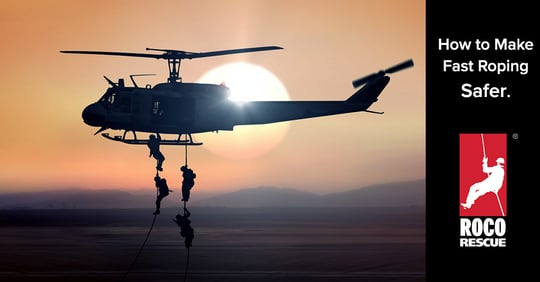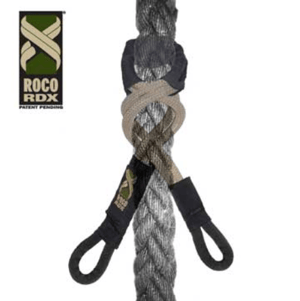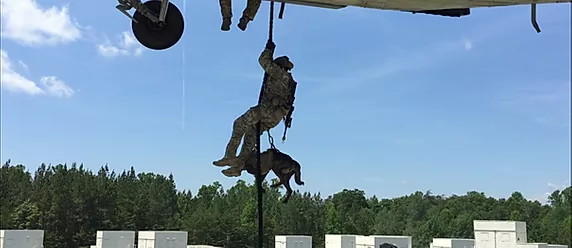An Innovation from Roco Rescue’s Ish Antonio
Pat Furr: Today I have the pleasure of interviewing one of my Roco Rescue colleagues, Ish Antonio who manages our Tactical Division. Ish will be telling us about the Roco RDX® which is a device that was developed in our Tactical Division and is used during helicopter fast rope insertions. This is not a device that would be used in your typical rescue effort, but for certain tactical operators, it makes their job significantly safer without compromising their speed of insertion.
This is not a device that would be used in your typical rescue effort, but for certain tactical operators, it makes their job significantly safer without compromising their speed of insertion.
Ish and I have known and worked together for nearly 40 years now, first as US Air Force Pararescuemen (PJs), and the last 19+ years with Roco Rescue. Our career paths in the Air Force were pretty intertwined, with Ish and I being assigned at the same unit a couple of times, and also with Ish assigned to a unit that provided fixed wing support for our helicopter squadron. In other words, we have a long history as both teammates and friends.
Ish has always been on the leading edge of coming up with innovative solutions to the operator’s needs. The Roco RDX is just such an innovation and I will let Ish explain what it does and how it works.
Ish Antonio: First, let’s talk about fast roping. We often arrive at the scene of an op by means of a helicopter, and frequently we can’t land the helicopter due to obstructions on the ground, or the landing zone is just too small, such as a rooftop in an urban environment. There are several options to get the operators inserted. They can be hoisted in using the aircraft hoist. They can rappel in using traditional rappel techniques. Or for large teams or for increased speed, the fast rope operation is the preferred method.
The fast rope technique uses a two and a half inch braided rope that is attached to a highpoint at the aircraft exit. The difference between a fast rope insertion and being hoisted or rappel, is that with a fast rope, there is no positive attachment between the rope and the operator.
So in essence, when you fast rope, you are holding on for dear life in the truest sense. Think of sliding down an old school fireman’s pole, only from much higher and usually at night with a lot of gear strapped to your body.
A lot of operators have been seriously hurt or worse with this technique due to missing the rope, falling off the rope, being knocked off the rope by a teammate, or being trampled at the ground by teammates landing on top. For most, the greatest hazard is exiting the aircraft and getting a good grip on the rope. It is a leap of faith and at night, on NVGs (night vision goggles), with a load of equipment and a line of teammates behind you, the potential to miss the rope is pretty high. Generally the aircraft will maintain about 5 knots of forward airspeed to avoid a dogpile at the bottom, but on tight LZ’s (landing zones) like the bridge of a ship or tight rooftop, it has to be in a stable hover and that’s when we have the potential for a dogpile. But the tradeoff is it gets the team inserted in minimal time and reduces the aircraft time on target.
PF: What is the RDX and how does it make fast roping safer for the operators as well as the canines?
IA: When we were active duty, we had our med kits, combat kit, survival vest or load bearing equipment, and other assorted odds and ends. It seems nowadays our operators are not only bigger, but they are loading out with much more and heavier kit. So the potential for coming off the fast rope is greater than ever.
The first version of a device to make fast roping safer is called the FREDS and it was developed about 15 years ago by a PJ named Tracy Barnet. The FREDS is a metal plate about the size of a dinner plate with integral friction bars much like a brake rack. To descend you had to actually lift the fast rope up to reduce tension. So, if you were in a higher hover or if there were people on the rope below you, then you would not be able to descend.
I got involved with the USAF Guardian Angel (GA) Program which you were also a part of, and I had already had an idea for a next generation device based on the alpine sandal wrap. Part of the GA Program was our heavy and light extrication packages which were both quite heavy. Add to that the K9 teams with a 60+ pound dog, and we are just adding more and more weight to the operator’s load, so we needed a device that would provide that positive connection, the added safety of a controlled descent, but would not require the rope below to be clear of personnel or so heavy that the weight would prevent the FREDS from descending. I didn’t push the idea for the Roco Double X (RDX) because everyone seemed happy with the FREDS. But as the load outs got heavier I wanted to provide a better device that was safer and also was able to function with a loaded fast rope.
The name RDX is short for “Roco Double X” and is so named because it is based on the Sandal Wrap, which is a friction knot and forms an X behind the rope and a second X in front of the rope. 
I’m fortunate to live near the Pararescue (PJ) School at Kirtland AFB and have access to their training tower. The PJs were very interested in this project so they were great at supporting us with access to the tower for development testing. After performing hundreds of fast ropes on the various prototypes we developed, starting with ½” kernmantle, we evolved to the PMI Aramid type Technora rope which handles the heat that is generated much better than Dacron rope. The Technora will handle upwards of 700 degrees Fahrenheit before seeing any adverse effects and we will never approach that level of heat generation, even with the longest fast ropes and heaviest weights. So I am comfortable saying it is over engineered for this type of application.
PF: Can you describe in a bit more detail the configuration of the RDX?
IA: The actual length of the RDX is just a shade over 41 inches. I originally had a handle at the apex of the RDX positioned right at the mid-point which is where you start the sandal wrap and then wrap downwards. The original handle wasn’t allowing us to modulate the speed of descent the way we wanted it to, so we changed to a friction pad wrapped in Nomex mounted in the same position which gives us the exact amount of control we were looking for.
PF: The RDX is actually quite a simple device. It is essentially a length of Technora rope sewn together to form a loop with the friction pad. How do you connect?
IA: That’s what is so great about this device. Because it’s a continuous loop which forms two closed loops at each end, we simply bring those two loops together at the bottom of the sandal wrap and clip in there.
The beauty of the RDX is it’s small enough to fit in a cargo pocket but it’s rated at over 22 kN so it can also be used as an anchor sling for other rope operations.
PF: So it’s not a one trick pony.
IA: Exactly. It can be used for multiple functions and it is much cheaper to produce than the FREDS - which is a one trick pony. The FREDS still has its place, but for personal use and the fact that the RDX is multi-function, we feel it’s the better choice.
PF: Who would be the primary users of this device?
IA: The US Navy has really gotten onboard with it and the K9 guys especially. The word is still getting out on the RDX but for any unit that uses fast rope, especially when loaded with a heavy kit or a dog, the RDX provides a simple and safe means of infiltration. 
PF: This sounds like a great device. So what are the potential downsides to using it?
IA: Keep in mind that the RDX forms a knot around the fast rope, so just like any knot, it requires initial training and proficiency maintenance training in order for it to be effective. That being said, the sandal knot is a very simple knot to tie and to remember how to tie.
PF: Will the RDX work on any fast rope?
IA: That’s a great question. The short answer is yes it will. We have tested it on virtually every fast rope that is being manufactured. The point to keep in mind is that fast ropes are generally in the range of two and a half inch diameter, but there is some variation in those diameters and in the coarseness of the weave as well as the materials used. So the RDX will perform slightly differently depending on the fast rope it’s mounted to. But it will certainly perform as we intended.
PF: Do you recommend training with the RDX mounted to the rope that you will be using operationally?
IA: Yes, in a perfect world that’s the best plan. But sometimes we end up operating with a unit that uses a different fast rope than the one we use at our unit. If possible, it’s best to at least do some ground training off a tower with that rope. But if that’s not available, it will perform reasonably similar between the different ropes.
PF: For me, the most dangerous part of fast roping was exiting the bird and getting a good grip on the rope.
IA: This is where the RDX really helps, especially for the operators with the bulkier, heavier loads and especially when you are maneuvering a 60+ pound K9 out of the airframe. The operator connects to the RDX prior to exit and thus has a positive connection and will not come off the rope. If they miss their grip, no worry as they will not start their descent until they handle the RDX on descent.
PF: Should the RDX be used for every operator on the infil?
IA: No, that’s not the intent. It’s really intended for the guys that have the extra heavy loads or the K9s. Everyone else just employs standard fast rope techniques. 
PF: What if you have multiple guys on the stick that have heavy loads or K9s?
IA: This is one of the benefits of the RDX. You can preposition them on the rope. Simply wrap them into the sandal wrap and attach a carabiner and they will stay in place. So if you have three guys on the stick that should use the RDX, stack three of them at the top of the rope, everyone else exits normally and the last three can quickly clip in one at a time and descend under control.
PF: What other features does the RDX include?
IA: We have a tether attached to the RDX with a quick release which also connects to the top of the fast rope with a girth hitch. This prevents the pre-rigged RDX from moving until it’s released. It’s important to ensure the tether is attached to the top of the fast rope and not to the airframe so the fast rope can be cut away once everyone is on the ground. The operator uses that tether while connecting to the RDX with the carabiner. Once he is connected he leans into the RDX to ensure that it’s positively connected and then releases the tether just before exit.
PF: Who do you see as your market for the RDX?
IA: The US Navy has adopted it and so have most of the Air Force PJ teams. But it’s still relatively new and I think it will take some time before the US Special Operations Command, and other federal and state agencies such as SWAT or similar federal assets get to know it. Our biggest orders right now are coming from Europe. The European special operators are more aligned with general alpinism and understand friction knots and know all about things like auto-blocks. They use them all the time, so the RDX makes perfect sense to them.
PF: Thanks so much for taking the time to chat today, Ish. Are there any last thoughts you would like to share about the Roco RDX?
IA: Our goal was to give the operators something that allows them to perform their mission with the degree of speed they need while at the same time adding a significant improvement in safety. We feel the RDX hits both those marks.
Editor's Note:
To see a 1-page pdf with pictures and key features:
https://www.rocorescue.com/product/rdx
To see a detailed video demonstrating many features of the Roco RDX, check out the video below from our YouTube channel:


 The beauty of these “rescue” skills is that most of them can be applied to everyday missions outside of the context of rescue. If you can haul Mongo onto a roof while he’s packaged in a Sked litter, then you can definitely haul up some equipment. If you can rappel into a well to save a fallen teammate and ascend back out, then you can access and bail out of OPs more quickly, safely, and efficiently. Lifting and extrication tools and techniques can be applied to SSE as well as rescue.
The beauty of these “rescue” skills is that most of them can be applied to everyday missions outside of the context of rescue. If you can haul Mongo onto a roof while he’s packaged in a Sked litter, then you can definitely haul up some equipment. If you can rappel into a well to save a fallen teammate and ascend back out, then you can access and bail out of OPs more quickly, safely, and efficiently. Lifting and extrication tools and techniques can be applied to SSE as well as rescue. During a recent Roco Combat Technical Rescue course onboard the USS Alabama, an elite group of Pararescuemen were called to the “real thing” when a ship worker took a fall and needed to be rescued. According to Roco Tactical Chief Instructor Alex Reckendorf, the PJ’s performed a flawless rope rescue and integrated well with the Mobile Fire Department. He added, “As trainers, we are obviously very proud of their performance during this unexpected event. They represented both Pararescue and Roco well and are a credit to their career field.”
During a recent Roco Combat Technical Rescue course onboard the USS Alabama, an elite group of Pararescuemen were called to the “real thing” when a ship worker took a fall and needed to be rescued. According to Roco Tactical Chief Instructor Alex Reckendorf, the PJ’s performed a flawless rope rescue and integrated well with the Mobile Fire Department. He added, “As trainers, we are obviously very proud of their performance during this unexpected event. They represented both Pararescue and Roco well and are a credit to their career field.”  The airmen secured his back and gave him the medical attention he needed while coming up with a game plan for how to use their ropes to get him down to the main deck and then off the ship.
The airmen secured his back and gave him the medical attention he needed while coming up with a game plan for how to use their ropes to get him down to the main deck and then off the ship. Roco Rescue is proud to announce that we have once again been awarded the privilege to provide Combat Technical Rescue Training and Specialized Equipment Kits to USAF Pararescue as part of the Guardian Angel Technical Recovery Program. Their dedication is reflected in their creed:
Roco Rescue is proud to announce that we have once again been awarded the privilege to provide Combat Technical Rescue Training and Specialized Equipment Kits to USAF Pararescue as part of the Guardian Angel Technical Recovery Program. Their dedication is reflected in their creed: For those who may not be familiar with this special group of USAF personnel, here’s more… Pararescuemen, also known as PJs, are United States Air Force Special Operations Command (AFSOC) and Air Combat Command (ACC) operatives tasked with recovery and medical treatment of personnel in humanitarian and combat environments. These special operations units are also used to support NASA missions and have been used to recover astronauts after water landings. They are attached to other SOF teams from all branches to conduct other operations as appropriate. They wear the maroon beret as a symbol of their elite status, and to symbolize the blood shed by past PJs, as well as the blood current PJs are willing to shed to save lives.
For those who may not be familiar with this special group of USAF personnel, here’s more… Pararescuemen, also known as PJs, are United States Air Force Special Operations Command (AFSOC) and Air Combat Command (ACC) operatives tasked with recovery and medical treatment of personnel in humanitarian and combat environments. These special operations units are also used to support NASA missions and have been used to recover astronauts after water landings. They are attached to other SOF teams from all branches to conduct other operations as appropriate. They wear the maroon beret as a symbol of their elite status, and to symbolize the blood shed by past PJs, as well as the blood current PJs are willing to shed to save lives.


